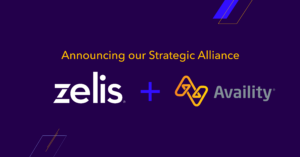We asked Jamie Brocki, VP of Customer Experience, to shed light on the provider experience & how payers can support providers in meeting digital demands.
Q: How do consumer digital demands impact providers?
Jamie Brocki: When it comes to healthcare, consumer demands have remained fairly consistent for over a decade. Patients want to interact with healthcare in the same way they do with other industries—largely digital-first. They want to skip the phone call and schedule online. They want to fill out forms ahead of time on their phone – and not in the waiting room. (And they sure don’t want to fill them out multiple times.) They also want bills they can understand – and then pay easily with modern payment technologies. And of course consumers are now way more familiar with virtual care – and really prefer it for certain situations. All these expectations drive the need for providers to adapt and evolve their services to meet digital demands.
Q: Why have some providers been slow to adapt to these changes?
Jamie Brocki: The reasons are multifaceted, ranging from the complexities of changing old systems and infrastructure to the challenges of managing change among their own clinicians. Many physicians don’t want to work evenings and weekends—despite the demand for more customer-friendly hours. They don’t want to offer online scheduling because they like how Mary does it – and she has done their scheduling for 20 years and knows their rhythms. Also, many providers feel more comfortable treating patients in person, so virtual care doesn’t feel natural to them. So you’ve got many provider systems really struggling to get the clinicians on board.
Q: How are digital demands for providers evolving?
Jamie Brocki: With margins being squeezed and staffing becoming a challenge, providers need digital solutions to drive efficiency, just like the rest of us. Electronic payments are one way they can get their money faster and eliminate manual processes. What does this look like? Often you have an environment where multiple people are tasked with opening envelopes, scanning checks, logging into literally 30 different health plan portals to investigate the details. Or they’re paying a lockbox company to do this for them. With electronic payments, you go to a more streamlined and efficient process where the money lands exactly where it’s supposed to—and the remittance from multiple payers can be centralized in one place.
Q: How do regulatory requirements impact digital transformation?
Jamie Brocki: I want to share a story: A number of years ago (in my prior life with a health plan) certain states required that payers mail a certificate of coverage to members—and in some states that was literally a 200-page document. Comprehensive, yes, but for the average member, it was also very overwhelming, very legalistic. And it really didn’t align with the relationship we wanted to cultivate. And so rather than just checking-the-box and doing what was asked in the regulation, we worked with the state to allow a different approach. Instead, we sent a welcome packet that gave the right level of information – and followed with a postcard that told them how to access that full 200-page version if they wanted it. We fully wanted to support transparency, but also believed that optionality was best for the member.
Q: How can providers and payers work together to create a more streamlined, clearer journey for their members?
Jamie Brocki: Of course we need to keep patients/members out of the fray and really make sure that nobody in the system is painted as a villain. Ultimately, both parties want to give their patients or members the best experience possible. We all care about things like NPS (Net Promoter Score) and satisfaction and engagement. I think the best thing we can do is take in customer feedback across the journey and actively evolve our businesses based on that feedback.
Get the full conversation on provider experience with Jamie Brocki as well as insights from other Zelis subject matter experts in our webinar:
Healthcare Payment Trends 2024: Future-proof Your Plan & Foster Provider Trust
LEARN MORE
By consolidating payments processes into a single, modernized platform, payers can better meet the needs of their provider base and support them in digital transformation. With the Zelis Advanced Payments Platform (ZAPP), payers get modernized payment delivery at scale with a large network of providers that is constantly growing. Zelis provides dedicated resources to help with ongoing enrollment support and training while the ZAPP payment platform can help reduce fraud exposure, accelerate sustainability initiatives, reduce waste and improve operational efficiency.
Visit the ZAPP page to learn more about how ZAPP can modernize the healthcare financial experience for everyone.

Jamie Brocki is the Vice President of Customer Experience at Zelis, responsible for working across the organization to help build and harmonize Payer, Provider and Member experiences. Brocki has had an extensive career in healthcare, including 17 years with one of the nation’s largest health plans where she held many roles across marketing and member engagement. She was part of the core team that drove the consumer transformation and launched a nationally recognized Plain Language program to address health literacy issues and consumer preferences. She also served on the provider side as VP, Consumer Strategy & Innovation at a regional health system. During her time there, she led the organization’s Consumer Experience strategy, helping to drive a 21-point increase in NPS over 2 years and earning recognition as the #1 hospital network in the region for Consumer Loyalty and, for the first time ever, among top 10 in the nation. Not bad for someone who started off her career at age 15 making young girls cry as an esteemed ear-piercer at Claire’s Boutique.



